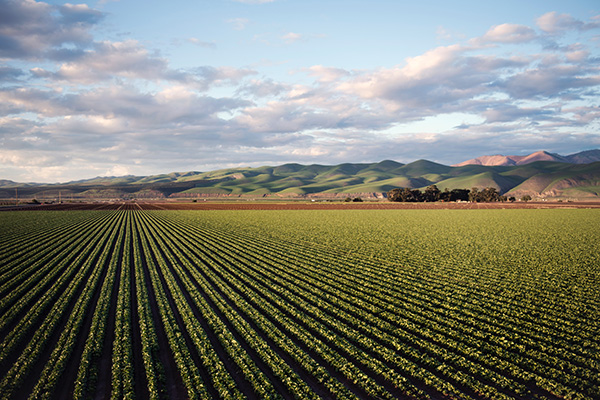What are
Real Assets?
The Asset Class that Touches
Every Aspect of the Global Economy
Getting real with the future of tangible real property — real assets. Discover why RPII and an increasing number of industry experts view real estate, infrastructure, timberland, and agriculture as a converging investment class of income-generating real assets.
-
Real Estate
Tangible property, including land, permanent structures, and associated rights above and below the land, along with the intangible ownership rights.
-
Agriculture & Timberland
Land assets that generate income and appreciate through commodity production, driven by biological growth, demographic shifts, and economic expansion.
-
Infrastructure
Durable assets that facilitate the transportation, storage, housing, and distribution of energy, information, goods, people, and social services.
The Fundamental Case for Real Assets
Unlike traditional stocks and bonds, the value of real assets is rooted in the tangible worth of underlying physical properties that are essential to economic productivity. Real assets, such as real estate, timberland, and agricultural lands, are vital to meeting basic human needs—shelter, food, and clothing—while infrastructure supports the effective functioning of communities and social systems.
Real assets stand out for their long-term intrinsic value, offering unique potential for income generation, production, and risk management. Despite differences among sectors, real assets share five key attributes that make them indispensable in a diversified portfolio.
Reason #1: Tangible Investments Comprise a Significant Portion of Global Wealth
Real assets constitute a substantial share of global wealth, second only to stocks and bonds, making them too significant to overlook. These assets offer diverse investment opportunities through both private and public equity and debt markets, each reflecting the intrinsic value and enduring nature of real assets. Unlike financial assets, real assets' worth are grounded in real-world properties or commodities.
As market demands have evolved, investment structures have adapted to provide broader access to real assets, capturing their intrinsic value. These structures now offer a range of options across the risk-return spectrum, featuring enhanced investor governance rights, incentive-based manager compensation, improved liquidity, and diversification requirements.

Reason #2: Real Assets Pave the Way for Sustainable Investment
With a growing focus on sustainability and ESG practices, real assets are uniquely positioned to drive sustainable investment. Real assets offer practical solutions to some of the world’s most pressing challenges, including climate change and social issues, making them essential for investors committed to creating a better future.
Environmental Resilience

Environment
Real Estate
Enhances environmental sustainability by improving energy efficiency in buildings and adopting renewable energy solutions.

Environment
Infrastructure
Facilitates the shift to cleaner energy by investing in and expanding renewable power systems.

Environment
Timberland
Contributes to carbon reduction and sustainable energy through responsible forest management, producing both carbon offsets and biofuels.

Environment
Agriculture Land
Supports climate resilience by sequestering carbon in the soil through advanced farming techniques.
Sustainability in Practice

Sustainability
Real Estate
Incorporates environmentally-friendly design, materials, and technologies in development, redevelopment, repositioning, and operational management to enhance sustainability.

Sustainability
Infrastructure
Applies sustainable principles addressing economic, social, and environmental factors to meet essential global service needs in transportation, energy, water, and social structures.

Sustainability
Timberland
Implements best practices in forestry management to reduce biowaste, protect sensitive old-growth forests, and safeguard endangered species and culturally significant lands.

Sustainability
Agriculture Land
Enhances sustainability by optimizing crop production and adopting improved management practices that promote biodiversity, protect sensitive habitats and watersheds, and improve soil health.
Championing Equity & Equality

Equity & Equality
Real Estate
Supports equity and equality by providing affordable housing and creating healthy, resilient buildings. These efforts are complemented by policies that protect workforces and foster community engagement with residents and tenants.

Equity & Equality
Infrastructure
Addresses racial wealth gaps and socioeconomic disparities by providing essential support networks and foundational services that underpin economic activity.

Equity & Equality
Timberland
Creates job opportunities in rural areas and preserves open spaces, recreational areas, and clean water resources, contributing to community well-being when managed responsibly.

Equity & Equality
Agriculture Land
Improves social and economic equity by addressing the shortcomings of traditional agriculture, focusing on fair treatment and opportunities for farm workers, tenant farmers, and farm owners through enhanced management practices.
Reason #3: Potential for Predictable and Stable Income Yields
Real assets have consistently delivered predictable, stable, and competitive long-term income returns across various market cycles, which can be particularly appealing for income-focused investors. Typically, 70-80% of these returns come from stable income streams, especially in core-oriented strategies. The reliability of these income yields stems from stable and contractual sources, such as lease agreements for real estate and tariffs or revenues from infrastructure projects.

Sampled Indices: High Yield Bonds: ICE BofA US High Yield Index; U.S. Real Estate: NCREIF Property Index; Global Real Estate: FTSE EPRA/NAREIT Developed Index; U.S. Agriculture: NCREIF Farmland Property Index; U.S. Bonds: Bloomberg Barclays U.S. Aggregate Bond Index; U.S. Timberlands: NCREIF Timberland Property Index; Non-U.S. Equities: MSCI ACWI Ex U.S. Index; Infrastructure: S&P Global Infrastructure Index; U.S. Equities: S&P 500 Index.
Reason #4: Long-Term Growth Potential
Real assets often appreciate over the long term, driven by factors such as population growth and urbanization, economic expansion, technological advancements, and scarcity. This long-term growth potential can provide significant capital appreciation. Real assets are typically suited for long-term investment horizons. Unlike some financial assets that may be subject to short-term market fluctuations, real assets often appreciate over time as they benefit from long-term economic and demographic trends.
Population Growth and Urbanization: As the global population continues to grow and urbanize, the demand for real estate, infrastructure, and agricultural products increases. This trend drives up the value of real assets, as more people require housing, transportation, and food.
Economic Expansion: Economic expansion and development typically lead to increased investments in infrastructure and real estate. As economies grow, there is greater demand for commercial spaces, residential properties, and infrastructure improvements, which can enhance the value and revenue potential of real assets.
Technological Advancements: Technological innovations can boost the value of real assets. For example, advancements in construction technologies and renewable energy can increase the efficiency and appeal of real estate and infrastructure investments. In agriculture, technological improvements in farming practices and crop management can lead to higher yields and better profitability.
Scarcity: Many real assets are inherently limited in supply. For instance, land is a finite resource, and prime locations for real estate or infrastructure are often scarce. This scarcity can drive up values over time, particularly as demand increases.

Reason #5: Diversification
Real assets enhance diversification and reduce risk in multi-asset portfolios. Research indicates that real assets generally exhibit low correlation with traditional asset classes such as stocks and bonds. This characteristic helps stabilize portfolios by lowering volatility, due to the diverse nature and distinct life cycles of real asset markets compared to financial assets.
Diversification within real assets occurs across various dimensions, including, to name just a few: geographic locations (global, regional, and metropolitan), sectors (property types, crop types, timber varieties, and infrastructure sectors like transportation and energy), operating strategies (core, core plus, value-add, and opportunistic), and investment approaches (lease versus own, re-development, and development). Additionally, diversification is supported by a range of investment managers and investment structures.

Reason #6: Hedge Against Unanticipated Inflation
Real assets historically offer a stronger hedge against unanticipated inflation compared to broader equity and fixed income markets, especially when supply and demand are balanced.
For real estate, factors like staggered leases, inflation-adjusted lease clauses, and triple net lease structures help transfer rising costs to tenants, enhancing inflation protection.
In infrastructure, contractual agreements often link directly to inflation measures, such as the Consumer Price Index, maintaining the asset’s value.
Similarly, commodities like timberland and agricultural products inherently align with inflation trends due to their connection to goods demand.

The Leading Voice of Real Assets Practice and Education
RPII brings together academics and practitioners in the real assets field to promote research and knowledge sharing. Our goal is to advance discussions through expert leadership and impactful insights, addressing the crucial need for further research and education on how real assets contribute to healthy environments, economic profitability, and social and economic equity.
Discover how real assets serve as the foundation to CERTIFIED REAL ASSETS ANALYST™ certification.

Begin Your Journey
Ready to Evolve?
Now is the time to embark on your real assets journey. Enhance your career potential and deepen your knowledge through the CRAA® Program. Gain in-depth insights, set yourself apart from the competition, and build real-world skills. See how you can register for CRAA® certification.
Enroll Now